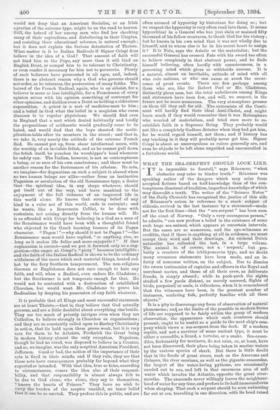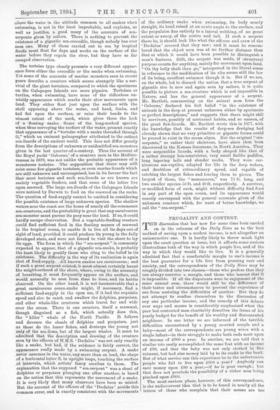WHAT THE SEA-SERPENT SHOULD LOOK LIKE.
" IT is impossible to foretell," says R6aumur, "what obstacles may arise to hinder truth." Reaumur was speaking rather of the dangers which may arise from accepted fictions based on half-knowledge than of the con- temptuous dismissal of tradition, imperfect knowledge of which may discredit a truth. The writer of the "Science Notes" of the Daily Chronicle has recognised the justice of this side of Reaumur's axiom in reference to a stock subject of ridicule, revived in the last instance by a statement—made not for the first time—that the " sea-serpent " has been seen off the coast of Norway. "Only a very courageous person," he admits, "can now profess a belief in the existence of some such huge sea.animal, which appears at uncertain intervals. But the cases are so numerous, and the eye-witnesses so credible, that if there is anything at all in evidence, we must accept their word and their drawings. An eminent Dutch naturalist has collected the last, in a large volume. The animal is, of course, not a serpent,' but pro- bably a creature of the ichthyosaurns type, and no doubt many erroneous statements have been made, and an in- finity of nonsense written, on the subject. But to dismiss the sworn testimonies of captains and officers in the Royal and merchant navies, and those of all their crew, as deliberate frauds, is simply absurd ; while to pooh-pooh the sights studied a few yards distant, as merely seaweed, flights of birds, porpoises, or seals, is ridiculous, when it is remembered that the witnesses have been, in the greatest number of instances, seafaring folk, perfectly familiar with all these objects."
It is a pity to discourage any form of observation of natural phenomena; ancl as the limits of the possible in modern forms of life are supposed to be fairly within the grasp of modern observation, the appearance which such creatures should present, ought to be useful as a guide to the next ship's com- pany which views a sea-serpent from the deck. If a modern reptile, and not a survivor of some ancient type, it must be either a crocodile, a lizard, a tortoise, or a snake. Sea-croco- diles, fortunately for mariners, do not exist, or, at least, have not been discovered, their place being taken in marine waters by the various species of shark. But there is little doubt that in the floods of great rivers, such as the Amazons and Orinoco, the river sanrians, as well as the gigantic anacondas, the largest of the water-loving pythons, are occasionally carried out to sea, and. left in that enormous area of soft water which invades the Atlantic, opposite the great river- mouths. The anaconda never willingly leaves the neighbour- hood of water for any time, and prefers to lie half-immersed even when sleeping. That such a serpent should be seen swimming far out at sea, travelling in one direction, with its head raised
above the water in the attitude common to all snakes when swimming, is not in the least improbable, and explains, as well as justifies, a good many of the accounts of sea- serpents given by sailors. There is nothing to prevent the existence of a gigantic sea-crocodile, though nobody has ever seen one. Many of those carried out to sea by tropical floods must float for days and weeks on the surface of the water before they regain the river, but they have so far escaped observation.
The tortoise type clearly presents a very different appear- ance from either the crocodile or the snake when swimming. Yet some of the accounts of marine monsters seen in recent years describe a creature which seems strangely like a sur- vival of the giant tortoises, compared to which the specimens on the Galapagos Islands are mere pigmies. Tortoises or turtles, when swimming, have none of the ridiculous un- wieldy appearance which marks their slow movements upon land. They either float just upon the surface with the shell appearing above the water, and head, limbs, and tail flat upon the surface, or raise their heads to the utmost extent of the neck, which gives them the look of a floating snake. Some of the long-necked species, when thus surveying the surface of the water, present exactly that appearance of a "tortoise with a snake threaded through it," which an eminent paleographer attributed to the extinct sea-lizards of the ancient world. This does not differ greatly from the descriptions of unknown or unidentified sea-monsters given in the last quarter-of-a-century. Thus the account of the Royal yacht Osborne,' of a creature seen in the Mediter- ranean in 1878, was not unlike the probable appearance of a monstrous tortoise. The supposition that there may still exist some few gigantic tortoises, or even marine lizards which are still unknown and unrecognised, has in its favour the fact that most tortoises and such sea-lizards as are known are mainly vegetable feeders, and that some of the latter live upon seaweed. The large sea-lizards of the Galapagos Islands were noticed by Darwin to feed on the seaweed on the rocks. The question of food-supply cannot be omitted in considering the possible existence of large unknown species. The shallow waters near the coast are the home of nearly all the commoner sea-creatures, and the probability is great that any carnivorous sea-monster must pursue its prey near the land. If so, it could hardly escape observation. But a vegetable-feeding creature could find sufficient food in the floating masses of seaweed in the tropical ocean, to enable it to live all its days out of sight of land, provided it could produce its young in the fully developed state, and were not forced to visit the shore to lay its eggs. The form in which the " sea-serpent " is commonly expected to appear, that of a gigantic sea-snake, is probably the least likely to gratify those who cling to the belief in its existence. The difficulty in the way of its realisation is again that of food-supply. All known snakes are carnivorous; and if such a great serpent existed, it must almost certainly haunt the neighbourhood of the shore, where, owing to the necessity of breathing, it must frequently appear on the surface, and would naturally be seen from time to time, and its habits observed. On the other hand, it is not inconceivable that a great carnivorous ocean-snake might, if necessary, find a sufficient food-supply in the open sea, if it had the requisite speed and size to catch and swallow the dolphins, porpoises, an.d other whale-like creatures which travel far and wide over the ocean. There is one creature, itself a mammal, though disguised as a fish, which actually does this,
the " killer " whale of the North Pacific. It follows and devours the shoals of dolphins and porpoises, just -as these do the lesser fishes, and destroys the young not only of the sea-lions, but of the largest whales. It must be admitted that the description and drawing of the creature seen by the officers of H.M.S. andalus ' was not only exactly like a snake, but had, if the evidence is fairly correct, the appearance really made by a swimming serpent. A snake never assumes in the water, any more than on land, the shape of a horizontal letter S, in upright loops, touching the surface At intervals, which artists' fancy ascribes to them. The explanation that the supposed "sea-serpent" was a shoal of dolphins or porpoises plunging one after another, is based on the notion that this represents the movement of a snake. It is very likely that many observers have been so misled. But the account of the officers of the 'Thedalus ' avoids this • common error, and is exactly consistent with the movements of the ordinary snake when swimming, its body nearly straight, its head raised at an acute angle to the surface, and the propulsion due entirely to a lateral writhing, of no great extent or sweep, of the centre and tail. If such a serpent there be, it should look like what the officers and crew of the Dmdalus ' averred that they saw ; and it must be remem- bered that the object seen was at no further distance than that at which it would have been possible to distinguish a man's features. Still, the serpent was made, if structural purpose counts for anything, mainly for movement upon land. "On thy belly shalt thou go," interpreted in the literal sense in reference to the modification of its ribs seems still the law of its being, excellent swimmer though it is. But if we are, on the whole, led to discard the notion that a true serpent of gigantic size is now and again Been by sailors, it is quite possible to picture a sea-creature which is not impossible in Nature, and has the general appearance of a serpent. Mr. Bartlett, commenting on the animal seen from the Osborne,' declared his full belief "in the existence of animals in the deep at present unknown either by specimens or perfect descriptions," and suggests that there might still be survivors, possibly of nocturnal habits, and so unseen, of the great fish-lizards. Mr. Bartlett wrote this in 1877, with the knowledge that the results of deep-sea dredging had already shown that no very primitive or gigantic forms could be proved to exist in the ocean abyss. But the original "sea- serpents," or rather their skeletons, have since then been discovered in the Kansas limestone, in North America. They were serpentlike lizards, with a body shaped like that of a rather stumpy boa-constrictor, very small finlike paddles, long tapering tails and slender necks. They were car- nivorous sea-reptiles, adapted for life in the deep waters, and doubtless of extraordinary speed, and capable of catching the largest fishes and tearing them to pieces. The largest of these, the " mosasa,urus," was 75 ft. long, and two smaller species 50 ft. and 40 ft. respectively. A survivor, or modified form of such, might without difficulty find food in any part of the open ocean, and its appearance would exactly correspond with the general accounts given of the unknown creature which, for want of better knowledge, we call the "sea-serpent."







































 Previous page
Previous page